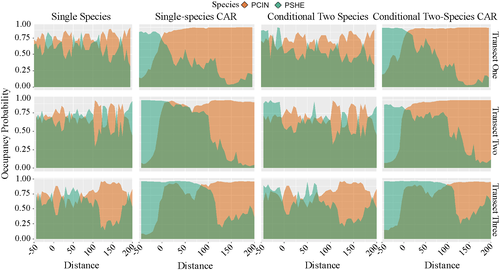Knowing your limits: estimating range boundaries and co-occurrence zones for two competing plethodontid salamanders
Abstract/Summary
Understanding threats to species persistence requires knowledge of where species currently occur. We explore methods for estimating two important facets of species distributions, namely where the range limit occurs and how species interactions structure distributions. Accurate understanding of range limits is crucial for predicting range dynamics and shifts in response to interspecific interactions and climate change. Additionally, species interactions are increasingly recognized as an important but not well understood predictor of range shifts. Our objective was to predict range limits and contact zones for two plethodontid salamanders, the highly range restricted Shenandoah salamander (Plethodon shenandoah) and the wide-ranging red-backed salamander (Plethodon cinereus ). Using detection/non-detection data, we assess four methodological decisions when estimating species’ distributions: 1) accounting for imperfect detection, 2) covariates to predict species occurrences, 3) accounting for species interactions, and 4) the inclusion of spatial autocorrelation. We found that Shenandoah salamander and red-backed salamander co-occurrence would have been underestimated and the range edge misidentified had we not accounted for incomplete detection. Covariates related to habitat were not sufficient to explain species’ range boundaries. Models that included spatial autocorrelation (i.e., a conditional autoregressive random effect) performed better than models that included just species interactions (i.e., detection and occurrence were conditional on the other species being present) and models that included both spatial autocorrelation and species interactions. Further, we found that the breadth of primary contact zones was typically 60 to 170 m, which is greater on average than previous estimates. In addition, we frequently observed secondary, disjunct contact zones along the range boundary. Understanding the extent to which species co-occur and how the range boundaries are shaped is crucial to conservation efforts. Our work indicates that accounting for detection is crucial for accurately characterizing range edges and that spatial models may be especially effective in modeling distributions at the boundary.
Publication details
| Published Date: | 2019 |
| Outlet/Publisher: | Ecosphere |
| Media Format: |
ARMI Organizational Units:
Southwest, Southern California - BiologyNortheast - Biology
Topics:
Monitoring and Population EcologySpecies and their Ecology
Place Names:
Shenandoah National ParkVirginia
Keywords:
conditional autoregressive modelsconditional occupancy
detection probability
joint species distribution model
range limit
red-backed salamander
Shenandoah salamander

